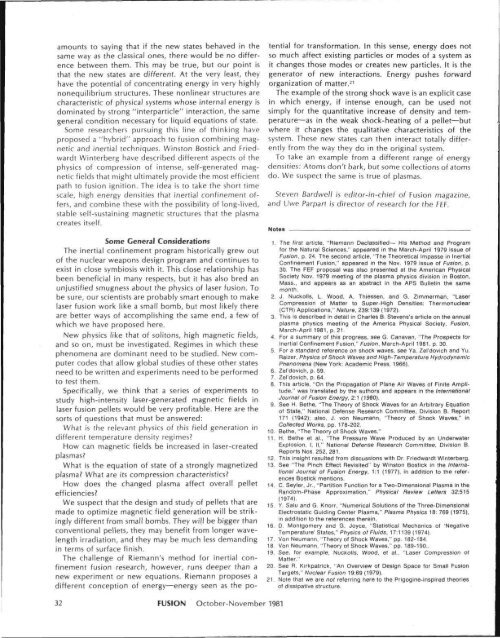Riemann's Contribution to Flight and Laser Fusion
Riemann's Contribution to Flight and Laser Fusion
Riemann's Contribution to Flight and Laser Fusion
- No tags were found...
Create successful ePaper yourself
Turn your PDF publications into a flip-book with our unique Google optimized e-Paper software.
amounts <strong>to</strong> saying that if the new states behaved in thesame way as the classical ones, there would be no differencebetween them. This may be true, but our point isthat the new states are different. At the very least, theyhave the potential of concentrating energy in very highlynonequilibrium structures. These nonlinear structures arecharacteristic of physical systems whose internal energy isdominated by strong "interparticle" interaction, the samegeneral condition necessary for liquid equations of state.Some researchers pursuing this line of thinking haveproposed a "hybrid" approach <strong>to</strong> fusion combining magnetic<strong>and</strong> inertial techniques. Wins<strong>to</strong>n Bostick <strong>and</strong> FriedwardtWinterberg have described different aspects of thephysics of compression of intense, self-generated magneticfields that might ultimately provide the most efficientpath <strong>to</strong> fusion ignition. The idea is <strong>to</strong> take the short timescale, high energy densities that inertial confinement offers,<strong>and</strong> combine these with the possibility of long-lived,stable self-sustaining magnetic structures that the plasmacreates itself.Some General ConsiderationsThe inertial confinement program his<strong>to</strong>rically grew ou<strong>to</strong>f the nuclear weapons design program <strong>and</strong> continues <strong>to</strong>exist in close symbiosis with it. This close relationship hasbeen beneficial in many respects, but it has also bred anunjustified smugness about the physics of laser fusion. Tobe sure, our scientists are probably smart enough <strong>to</strong> makelaser fusion work like a small bomb, but most likely thereare better ways of accomplishing the same end, a few ofwhich we have proposed here.New physics like that of soli<strong>to</strong>ns, high magnetic fields,<strong>and</strong> so on, must be investigated. Regimes in which thesephenomena are dominant need <strong>to</strong> be studied. New computercodes that allow global studies of these other statesneed <strong>to</strong> be written <strong>and</strong> experiments need <strong>to</strong> be performed<strong>to</strong> test them.Specifically, we think that a series of experiments <strong>to</strong>study high-intensity laser-generated magnetic fields inlaser fusion pellets would be very profitable. Here are thesorts of questions that must be answered:What is the relevant physics of this field generation indifferent temperature density regimes?How can magnetic fields be increased in laser-createdplasmas?What is the equation of state of a strongly magnetizedplasma? What are its compression characteristics?How does the changed plasma affect overall pelletefficiencies?We suspect that the design <strong>and</strong> study of pellets that aremade <strong>to</strong> optimize magnetic field generation will be strikinglydifferent from small bombs. They will be bigger thanconventional pellets, they may benefit from longer wavelengthirradiation, <strong>and</strong> they may be much less dem<strong>and</strong>ingin terms of surface finish.The challenge of <strong>Riemann's</strong> method for inertial confinementfusion research, however, runs deeper than anew experiment or new equations. Riemann proposes adifferent conception of energy—energy seen as the potentialfor transformation. In this sense, energy does notso much affect existing particles or modes of a system asit changes those modes or creates new particles. It is thegenera<strong>to</strong>r of new interactions. Energy pushes forwardorganization of matter. 21The example of the strong shock wave is an explicit casein which energy, if intense enough, can be used notsimply for the quantitative increase of density <strong>and</strong> temperature—asin the weak shock-heating of a pellet—butwhere it changes the qualitative characteristics of thesystem. These new states can then interact <strong>to</strong>tally differentlyfrom the way they do in the original system.To take an example from a different range of energydensities: A<strong>to</strong>ms don't bark, but some collections of a<strong>to</strong>msdo. We suspect the same is true of plasmas.Steven Bardwell is edi<strong>to</strong>r-in-chief of <strong>Fusion</strong> magazine,<strong>and</strong> Uwe Parpart is direc<strong>to</strong>r of research for the FEF.Notes1. The first article, "Riemann Declassified— His Method <strong>and</strong> Programfor the Natural Sciences," appeared in the March-April 1979 issue of<strong>Fusion</strong>, p. 24. The second article, "The Theoretical Impasse in InertialConfinement <strong>Fusion</strong>," appeared in the Nov. 1979 issue of <strong>Fusion</strong>, p.30. The FEF proposal was also presented at the American PhysicalSociety Nov. 1979 meeting of the plasma physics division in Bos<strong>to</strong>n,Mass., <strong>and</strong> appears as an abstract in the APS Bulletin the samemonth.2. J. Nuckolls, L. Wood, A. Thiessen, <strong>and</strong> G. Zimmerman, "<strong>Laser</strong>Compression of Matter <strong>to</strong> Super-High Densities: Thermonuclear(CTR) Applications," Nature, 239:139 (1972).3. This is described in detail in Charles B. Stevens's article on the annualplasma physics meeting of the America Physical Society, <strong>Fusion</strong>,March-April 1981, p. 21.4 For a summary of this progress, see G. Canavan, "The Prospects forInertial Confinement <strong>Fusion</strong>," <strong>Fusion</strong>, March-April 1981, p. 30.5. For a st<strong>and</strong>ard reference on shock waves, see Ya. Zel'dovich <strong>and</strong> Yu.Raizer, Physics of Shock Waves <strong>and</strong> High-Temperature HydrodynamicPhenomena (New York: Academic Press, 1966).6. Zel'dovich, p. 59.7 Zel'dovich, p. 64.8. This article, "On the Propagation of Plane Air Waves of Finite Amplitude,"was translated by the authors <strong>and</strong> appears in the InternationalJournal of <strong>Fusion</strong> Energy, 2:1 (1980).9. See H. Bethe, "The Theory of Shock Waves for an Arbitrary Equationof State," National Defense Research Committee, Division B. Report171 (1942); also, J. von Neumann, "Theory of Shock Waves," InCollected Works, pp. 178-202.10. Bethe, "The Theory of Shock Waves."11. H. Bethe et al„ "The Pressure Wave Produced by an UnderwaterExplosion, I, II," National Defense Research Committee, Division B.Reports Nos. 252, 281.12. This insight resulted from discussions with Dr. Friedwardt Winterberg.13. See "The Pinch Effect Revisited" by Wins<strong>to</strong>n Bostick in the InternationalJournal of <strong>Fusion</strong> Energy, 1:1 (1977), in addition <strong>to</strong> the referencesBostick mentions.14. C. Seyler, Jr., "Partition Function for a Two-Dimensional Plasma in theR<strong>and</strong>om-Phase Approximation," Physical Review Letters 32:515(1974).15. Y. Salu <strong>and</strong> G. Knorr, "Numerical Solutions of the Three-DimensionalElectrostatic Guiding Center Plasma," Plasma Physics 18: 769 (1975),in addition <strong>to</strong> the references therein.16. D. Montgomery <strong>and</strong> G. Joyce, "Statistical Mechanics of 'NegativeTemperature' States," Physics of Fluids, 17:1139 (1974).17. Von Neumann, "Theory of Shock Waves," pp. 182-184.18. Von Neumann, "Theory of Shock Waves," pp. 189-190..19. See. for example, Nuckolls, Wood, et al.. "<strong>Laser</strong> Compression ofMatter."20. See R. Kirkpatrick, "An Overview of Design Space for Small <strong>Fusion</strong>Targets," Nuclear <strong>Fusion</strong> 19:69 (1979).21. Note that we are not referring here <strong>to</strong> the Prigogine-inspired theoriesof dissipative structure.32 FUSION Oc<strong>to</strong>ber-November 1981
















